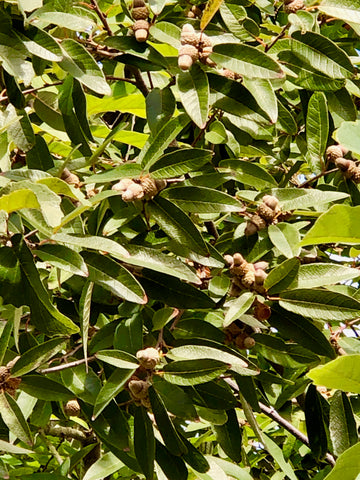Oaks & Acorns: The Mystery of the Mast
Did you know that the Oak trees of North America produce more nuts than any other tree region worldwide, cultivated or wild?
The fruit of an Oak tree is an acorn. A single giant Oak tree can produce nearly ten thousand acorns in a reproductive season. However, Oak trees do not bear fruit every year and some acorns require up to 18 months to mature. When a forest nut-bearing tree, like an Oak, Pecan, or Walnut, produces a high yield or bumper crop, the year is botanically referred to as a 'mast' year.

This 'Big Tree' is a coastal live oak, Quercus virginiana, and has lived more than a thousand years along the Texas Gulf Coast. Many of the surrounding oak trees are its offspring. How many mast years has this mighty tree experienced?
What is a Mast Year?
Mast is a term used to describe the fruit of forest trees and shrubs. The fruit can be hard nuts, like acorns or beechnuts, or soft, like blueberries or wild grapes, and are an important food source for wildlife. A mast year is when a particular woodland species produces more fruit than normal. Like many trees, Oaks have irregular cycles of high and low yields. Oak masting happens every 2- 5 years.
Why Do Oaks Mast?
Scientists are uncertain as to the exact reason why oaks and other plants mast but there is a range of theories from climate temperatures and rainfall amounts to harsh summers affecting acorn production or the availability of spring winds during pollination. The specific causes remain a mystery, but one undeniable evolutionary benefit of masting is... ensured future offspring.

Acorns are the easiest way to identify an Oak tree. There are over 600 species of Oak trees with more than 200 species endemic to North America. This elliptical oak shaped leaf indicates a Mexican White Oak tree and can be found growing as far south as Guatemala.
In mast years, acorns fall by the thousands increasing food availability for squirrels, mice, birds, and other forest frugivores. During mast events, dependent wildlife populations increase. The following year, the trees will bear little to no fruit due to the abundance of energy required to produce the previous year's bountiful harvest. In subsequent low to no yield years, wildlife populations decrease as food becomes scarce. Then in a mast year, the overflowing harvest will more than feed the forest critters and ensure some seeds left to grow into future oak trees.

Oaks in Peril
Imagine driving down a country road, sun shining, rolling meadows of green grass only to be delightfully interrupted by a large Oak tree standing gloriously alone. Romantic, yet a cause for concern. Many new Oak trees in the United States are planted on private properties. The forests are rapidly changing. Oaks are at risk due to logging, diseases, insect invaders, drought conditions, wildfires, and urban sprawl. When considering a new oak tree for your landscape, ask experts in your area which native oak tree species are dwindling in population and plant those species rather than the local garden center's popular oak trees. Together we can increase the diversity of the species simply by planting a rare native oak in our own gardens. And that's garden activism in action.
For more insight into the importance of Oak Trees, these recommended books are insightful and informative. Each book supports independent book stores in partnership with Bookshop.org A purchase helps support the journey at no additional cost to you.
18 comments
Regarding why an oak might grow many acorns and then less and less because fruits and nut trees only have so many years of fruits like an apple tree grows a few years begins fruiting then stops it can grow many years without fruits this is generally hoe it works but sometimes they have they have their own rules.
I really have to question what I read sometimes… such as an oak tree can produce up to 10,000 acorns and don’t produce every year and it’s 10,000 only on bumper years.
Well I seem to have a tree that doesn’t conform.. The tree was here when we bought the house 36 years ago and was already maybe 40 years old.
We have acorns EVERY year and EVERY year seems to be a bumper year. We must collect between 12-15 10 ltr buckets full of acorns in a season. Blowing them every 4-5 days together in a big pile on the lawn with a heavy duty blower.
Taking an average acorn to be about 3cc and 10,000 cc in a bucket, each bucket almost full would be at least 2500. 15 buckets would be nearing 40,000 acorns.. and that’s every year.
And then there’s the also the two trailer loads full of the leaves I take away.
If the tree hadn’t been put on a monument list, I’d think of cutting it down. It’s a lot of mess to clear up every year..
We live in Nevada City California, at 2450 ft elevation. About at the boundary line between California black oak and live oak. In the 24 years we have been here there is the largest mast year we have experienced. Once it warms up mid morning we are bombarded with black oak acorns this year from the over reaching tree that it precludes sitting on the deck. Sometimes it seems l8ke a Midwest hail storm.
Our Live Oaks in TX are producing at massive clip following a brutal summer. The sound of acorns falling on our roof is a constant and the squirrels seemed overwhelmed by the bounty.
We live in coastal SC, our oaks and surrounding neighbors have had more acorns this year than I have seen in a while.
It was raining acorns!!
I raked up buckets from yard and dispersed in appropriate areas for wildlife and placed in bare spots where a future oak could possibly grow.